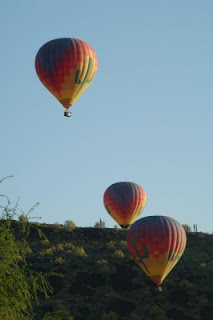
According to Greek legend, the venomous sting of a scorpion killed Orion, the great hunting god. One of many stories about Orion’s fate tells that the Greek goddess Artemis cursed him with the fatal sting because she was jealous of his courting Dawn, the goddess of morning. During the summer, the constellation Orion can be seen lying down on the eastern horizon, greeting his lover just as the sun rises. At the same time, the constellation Scorpius sets to the west. Likewise, Orion is most visible in the night sky in mid-winter, opposite Scorpius, which some say is because they are carefully avoiding each other.
During mid-summer, stars that make up the sweeping spiral tail and claws of the constellation Scorpius dominate the southern night sky. These are clearly visible even around the light drenched city of Phoenix. At the heart of Scorpius shines Antares, a huge star 300 times the size of our sun. The name Antares is Greek for “rival of Mars,” because they both glow red and are about the same size to our eyes when viewed from Earth. However, if Antares were the center of our solar system, it would swallow Mars and reach almost to the planet Jupiter!
Summer nights are also the most likely time that you will see a living scorpion in the desert, since they are nocturnal and more active during warmer months. Scorpions have been very successful, having survived over 350 million years on our ever-changing planet. Of the 1500+ species known world wide, 90+ are found in the U.S.; about thirty live in both wild and tamed regions of Arizona. Three of these are common, and likely to be seen in the Phoenix area if one cares to look for them. The most spectacular but least common of the three is the giant hairy desert scorpion, a dark-skinned beast that grows up to six inches long. Although frightening to look at, this species is not very toxic to humans. But if you were an insect, lizard, spider, or other scorpion, you would definitely want to stay out of their way.
The less intimidating striped devil scorpion grows to less than three inches long, and is blonde or tan with broad dark stripes down the length of their backs. This species is also not life threatening to humans, though the sting can be very painful.
The bark scorpion is the only one in our area that is highly toxic to humans. They are also blonde and similar in size to the striped devil, but lacking the stripes. A well-aimed sting from a bark scorpion can immobilize a 250-pound man, and could be fatal to a small child, unhealthy adult or small pet. The powerful neurotoxin causes numerous symptoms including a sharp tingling sensation, numbing, uncontrolled breathing, muscle spasms, and general aching. Some people suffer allergic reactions to the sting as well. These are the kind that are most common in our neighborhood.
My friend Christy was kind enough to bring me the above photographed specimen that she caught in a jar in her back yard. The wildlife watching was fun for the family until one morning when 22 baby scorpions appeared on momma's back. Something about all that neurotoxin freaks most people out. But I am delighted to have a friend who cares enough to show me local wildlife rather than just flushing it down the toilet as most people would do in this case!
Fortunately, scorpions are not aggressive towards humans, and will only sting if threatened, such as when they get stuck between your shoe and your foot. They hide in rock crevices or burrows in the soil during the day, when humans are more likely to be outside. At night when they are active, it is not uncommon to see one cruising down the sidewalk or crawling on a tree trunk. If you shine a black light around your yard or in the desert on a moonless night, you will be able to easily find them glowing greenish white in the dark. Other than humans, the main predators of scorpions are nocturnal animals including snakes, mice, shrews, elf owls and other scorpions.
Although it is true that the sting of some species of scorpion can be fatal to even a very strong man, this is extremely rare. According to current medical records, there have only been two deaths in Arizona due to scorpion stings since 1968. Compared to other risks we face each day, these creatures are relatively benign. If you can overlook their venomous capability, they are fascinating to see and watch.
However, if you do not feel comfortable sharing your space with scorpions, be sure to keep your yard tidy and free of debris where they like to hide. Look carefully before you put your hands or feet under rocks, in woodpiles, or even when moving outdoor potted plants. Don’t leave close-toed shoes outdoors and avoid going outside barefoot at night. You can also have an exterminator treat your property with a special arachnid poison. Scorpions are not insects, so insecticides will not affect them. However, insecticides are useful if you want to eliminate prey that would attract scorpions to your home.

































